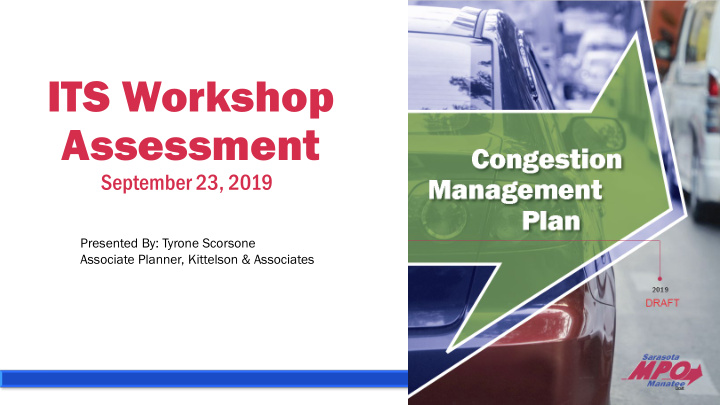



ITS Workshop Assessment September 23, 2019 Presented By: Tyrone Scorsone Associate Planner, Kittelson & Associates
Federal H Hig ighway A Administ istration (F (FHWA) ) Congestion Management Plan (CMP) Eight step process
CMP Area and Network • Step 2 in the process is to define the study area • Step 3 in the process is to define the network Image from pg 6 of CMP
Analyzed Performance Image from pg 21 of CMP
Peak Season Analysis Image from pg 18 of CMP (not – peak season)
Opportunities Image from pg 22 of CMP
Multiple criteria went into identifying the intersections and segments: Prioritized • Safety Locations • Delay • Reliability • Presence of existing ITS infrastructure
Inventory • Existing infrastructure • Existing projects (planned or programmed) Image from pg 42 of CMP
• Mobility measures Monitoring • Collecting data Strategy • Device deployment Effectiveness • Before & After studies
Add CMP projects to Project Priority List Implement CMP projects Recommendations Assess the efficiency and effectiveness of CMP projects
Performance Measures Level of Truck Length of Travel Travel segment ITS (longer Safety Delay Time Time Significance segments, Reliability Reliability higher ( LOTTR ) (TTTR) priority) ATMS project Identification Top 25% or 35 unique segments
Top 25% or 35 unique segments • Approximately 90 miles in corridors • 20 miles on I-75 • Minimum corridor length was 0.25 mi • Maximum corridor length was 12.25 mi • Two or more performance measures triggered by top corridors • 2 corridors had 4 performance measures identified • 15 corridors had 3 performance measures identified
Top 25% or 35 unique segments • Arterial and freeway mitigation strategies are needed • Mitigation strategies identified to target location specific performance: • Ramp Metering • Incident Response Vehicles • Managed Lanes • Traveler Information • Variable Speed Limits • Adaptive Signal Control • Arterial Management • Instrument Deployment
Countywide or regionwide strategies • Some strategies are to be deployed as a region or countywide rather than corridor specific: • Incident Response Vehicles - $2,500,000 • Managed Lanes - TBD • Traveler Information - TBD
Ro Road Length h Mitigation on Approximate Approximate Name Fr From To Chal allen enge ge Ar Areas eas Plan Pl anned Pr Projec ects (mi.) .) Strategi egies es Ca Capi pital Co Cost Annu nnual Co Cost $72,000 $8,000 Ramp Metering Incident - $2,500,000 Response Vehicles SR 64 / SR Safety, Delay, I-75 at SR 64 Interchange I-75 Manatee 4.11 $56,700,000 - 301 LOTTR, TTTR Improvement; Landscaping Managed Lanes Avenue Traveler $241,500 $10,000 Information Variable Speed $12,000 - Limits
Co Corridor Length h Chal allen enge ge Plan Pl anned es Approximate Approximate mber Road ad Name Name Fr From To Mitigation S Strategi gies Numb (mi.) .) Areas Projects Ca Capi pital Co Cost Annu nnual Co Cost Incident Response - $2,500,000 Vehicles Adaptive Signal $272,728 - S of Control US 41 / Vamo Safety, Bike 7 Bayshore 6.79 Tamiami Trail Road Delay, ITS Lane/Sidewalk Drive $44,000 $3,000 Arterial Management Instrument $141,693 - Deployment
Corridors with performance measures identified as a priority but not in top 25%
Additional opportunities to expand ATMS • Delay Significance (HERE Data, Peak Hour, Daily Delay) strategies • Level of Travel Time Reliability Significance (non-reliable segments) • Truck Delay Significance (NPMDRS)
Recommend
More recommend